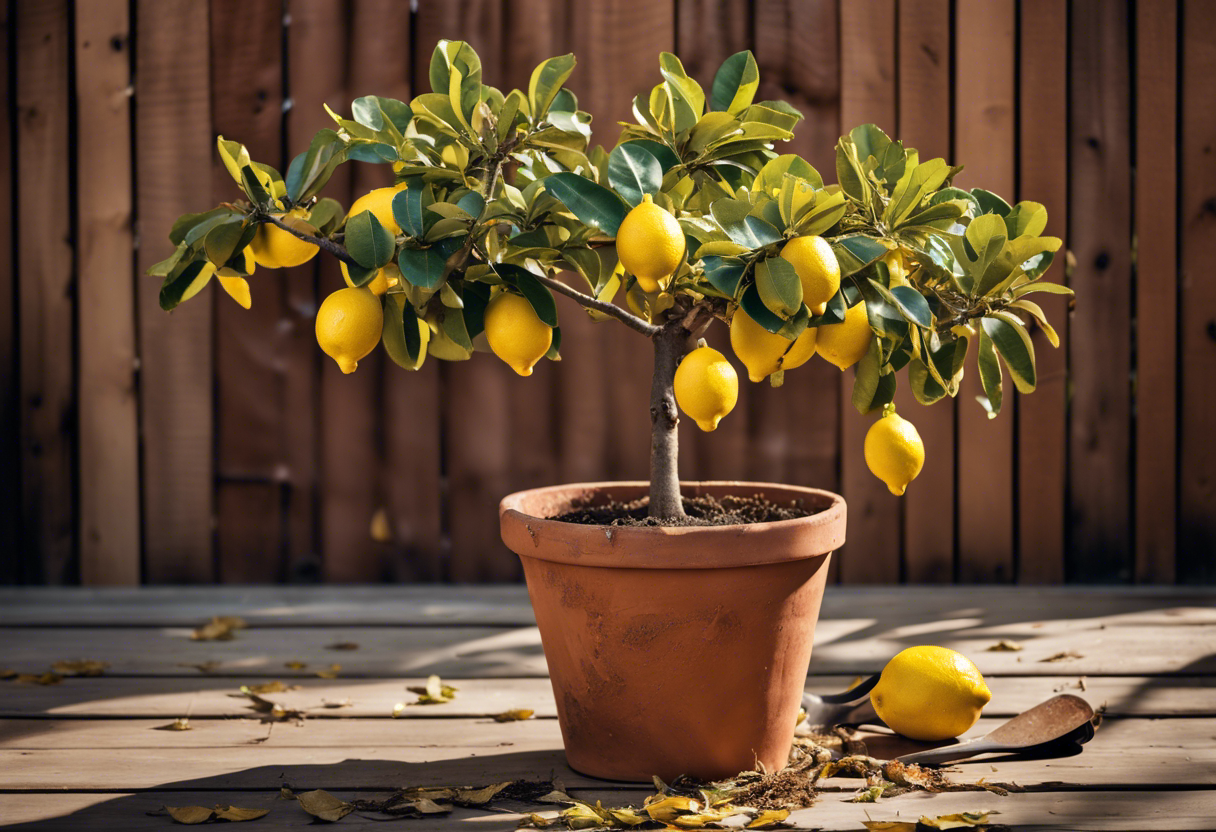Ever found yourself staring at your beloved lemon tree, scratching your head and muttering, “Why is my Lemon Tree Losing Leaves?” Well, you’re not alone. This is a common conundrum faced by many citrus lovers around the globe.
But fret not! Leaf loss in lemon trees can be quite alarming but it’s often a sign of something that can be fixed. So buckle up, fellow green thumbs! We’re about to embark on a journey to save our leafy friends from their untimely demise. Keep reading about Lemon Tree Losing Leaves? (How to Save it).
Key Takeaways
- Lemon trees lose leaves due to overwatering, underwatering, nutrient deficiencies, pests or diseases.
- Overwatering can lead to root rot; ensure the soil is well-draining and water only when the top inch of soil is dry.
- Underwatering causes wilting and leaf drop; water deeply but infrequently.
- Nutrient deficiencies, especially nitrogen, can cause yellowing and leaf drop. Use a citrus-specific fertilizer.
- Regularly check for pests like aphids or scale insects. Use insecticidal soap or neem oil for control.
- Diseases like citrus canker can cause leaf loss. Consult a professional for treatment options.
Why is My Lemon Tree Losing Leaves?
Ah, the mystery of the lemon tree losing leaves. It’s a common concern for many citrus lovers. There are several reasons why this might happen, ranging from natural processes to more alarming causes.
Understanding the Normal Leaf Shedding Process
First off, let’s talk about the normal leaf shedding in citrus trees. Just like us humans changing our wardrobe with seasons, lemon trees have their own fashion cycle too! They shed old leaves and sprout new ones as part of their growth process.
This natural cycle of lemon tree defoliation usually happens during seasonal changes. So if you notice your lemon tree losing leaves in summer or winter, don’t panic just yet! It could be just a regular seasonal leaf drop in lemon trees.
But how can you tell if it’s normal? Well, healthy lemon tree leaf drop patterns are pretty easy to spot. The tree will lose some leaves but not all at once and new ones will start to grow soon after.
Identifying Abnormal Leaf Loss
Now that we’ve covered the basics of normal leaf loss, let’s dive into the signs of an unhealthy lemon tree losing leaves abnormally. If your tree is dropping leaves excessively or out of season, it might be a sign of trouble.
One way to recognize this is by looking for symptoms of abnormal citrus tree defoliation. Are there yellowing leaves? Is there a sudden and drastic leaf drop? These could be red flags indicating an issue.
Another thing to consider are potential causes behind this excessive leaf loss. Pests, diseases or environmental stress could all lead to your lemon tree waving goodbye to its foliage prematurely.
So remember folks – keep an eye on your citrus buddy and don’t ignore any unusual signs! Your lemon tree will thank you for it.
Common Causes of Leaf Loss in Lemon Trees
When your Lemon Tree Losing Leaves, it’s like a cry for help. Let’s dive into the common reasons behind this citrus calamity.
Inadequate Watering
Water, or lack thereof, can be a major player in lemon tree leaf loss. Too much water and you’ll drown the poor thing, leading to root rot and leaf drop. On the flip side, too little water leaves your tree parched and stressed, causing leaves to shrivel up and fall off.
The key is balance. Your lemon tree needs just enough water to keep its roots moist but not soggy. So next time you’re tempted to give it a good drenching or forget about watering altogether, remember – moderation is key!
Nutrient Deficiencies
Just like us humans, lemon trees need their vitamins too! Lack of certain nutrients can lead to reasons for lemon tree defoliation. Nitrogen, phosphorus, potassium – these are all essential nutrients for healthy growth.
If your lemon tree is lacking any of these vital nutrients, it might start shedding leaves as a distress signal. So don’t skimp on that fertilizer – your tree will thank you!
Pests and Diseases
Bugs and diseases are another common cause of leaf drop in citrus trees. From aphids to citrus canker disease, these tiny terrors can wreak havoc on your beloved lemon tree.
These pests and diseases not only cause leaf loss but also affect overall plant health. So if you notice any unusual spots or creepy crawlies on your tree, it’s time to take action!
Environmental Stressors
Mother Nature isn’t always kind to our citrus friends either. Extreme temperature fluctuations or poor soil conditions can lead to lemon tree losing leaves.
Too hot or too cold temperatures stress out the tree causing leaf drop while poor soil conditions can hinder root development. So, keep an eye on the weather and test your soil regularly to ensure it’s just right for your lemon tree!
How to Diagnose the Problem
When your lemon tree is losing leaves, it’s time to play detective. The first step in solving this leafy mystery is a thorough lemon tree diagnosis. You gotta look at the overall health, check for creepy crawlies or signs of disease, and inspect the soil and water conditions.
Examining the Tree’s Overall Health
Start by giving your citrus buddy a good once-over. Look at its leaves – are they shiny and green or do they look more like old lettuce? Next, check out the branches. Are they strong and sturdy or do they remind you of grandma’s brittle hair? And don’t forget about fruit production! If your tree is popping out lemons like a vending machine, that’s a good sign. But if it’s stingier than Scrooge with its fruits, there might be an issue. This assessing citrus tree health process will help you identify any signs of unhealthy lemon tree.
Checking for Signs of Pests or Disease
Next up on our lemon tree losing leaves investigation: pests and diseases. These unwanted guests can cause all sorts of problems for your citrus friend. Look for tiny bugs crawling around or unusual spots on the leaves – these could be signs of common lemon tree pests and diseases. Also, keep an eye out for any funky smells or weird growths – these could indicate some sort of disease.
Assessing Soil and Water Conditions
Lastly, let’s talk dirt and water – two things your lemon tree can’t live without but can also cause it harm if not balanced right. Your lemon tree likes well-draining soil that’s slightly acidic – think coffee grounds after you’ve made a pot o’ joe. If the soil is too wet or too dry, it can lead to leaf loss in lemon trees. Same goes for watering – too much can drown your tree, too little can leave it parched. So, keep an eye on these lemon tree soil requirements and make sure you’re watering citrus trees properly.
Solutions to Prevent Leaf Loss in Lemon Trees
When it comes to lemon tree care, a few things are non-negotiable. Watering, nutrient balance, pest control and environmental conditions all play crucial roles. Let’s dive into how you can prevent leaf loss and keep your lemon trees healthy.
Adjusting Watering Techniques
First off, let’s talk about watering. If your lemon tree is losing leaves, improper watering could be the culprit. Too much water can cause root rot, while too little can lead to dehydration.
So, what’s the sweet spot? Well, it depends on your climate and soil type. But as a rule of thumb, deep watering once a week should do the trick. Just make sure the top 2 inches of soil dry out between waterings.
Correcting Nutrient Imbalances
Next up – nutrients! A nutrient deficiency in lemon trees can lead to leaf loss faster than you can say “citrus”. To avoid this, ensure your soil pH is between 6 and 7.5 for optimal nutrient absorption.
If you notice yellow leaves or stunted growth, it might be time for some citrus fertilizer. Remember folks, a well-fed tree is a happy tree!
Treating Pests and Diseases
Alrighty then! Now onto pests and diseases – every gardener’s worst nightmare. Common culprits include aphids, scale insects and citrus leaf miners.
The good news? There are plenty of organic pest control options for citrus trees available today! So don’t panic if you spot some creepy crawlies on your beloved lemon tree.
Modifying Environmental Conditions
Last but not least – environment! Yes folks, even plants have their preferred living conditions. For lemon trees, that means lots of sunlight (at least 6 hours per day) and temperatures between 55°F and 85°F.
If you’re growing an indoor lemon tree, make sure it’s near a sunny window. And remember, sudden temperature changes can cause leaf drop, so try to keep conditions as stable as possible.
Maintenance Tips for Healthy Lemon Trees
To avoid your lemon tree losing leaves, it’s crucial to understand the importance of regular maintenance. It’s all about lemon tree care and keeping those healthy lemon trees thriving. Let’s dive into pruning, fertilization, and pest prevention.
Regular Pruning Practices
Pruning isn’t just for looks; it’s a vital part of citrus tree pruning. When you prune, you’re essentially giving your tree a little health check-up. You’re looking for any signs of disease or pests and removing them before they can spread.
But when is the best time to whip out those shears? Well, most folks agree that when to prune lemon trees is usually in late winter or early spring. But remember, every tree is unique, so what works for one might not work for another.
The key takeaway here? Regular pruning helps maintain your tree’s health and productivity. So don’t be afraid to get snipping!
Optimal Fertilization Methods
Next up on our list of lemon tree maintenance tips is fertilization. Now, I know what you’re thinking: “Why do I need to feed my trees?” Well, think about it this way: just like us humans need a balanced diet to stay healthy, so do our leafy friends.
Fertilizing isn’t just about making your trees grow bigger; it’s about providing them with the nutrients they need to thrive. And when it comes to fertilizing lemon trees, there are plenty of options available.
Whether you choose organic compost or a specially formulated citrus tree fertilizer, the important thing is that you’re giving your trees the nutrients they need. So next time you’re out in the garden, remember: feed your trees!
Pest Prevention Strategies
Last but certainly not least on our list of maintenance tips is pest prevention. Now, I know what you’re thinking: “Pests? In my garden?” Unfortunately, it’s more common than you might think.
From aphids to citrus leaf miners, there are plenty of lemon tree pests out there ready to make a meal out of your precious trees. But don’t worry, with the right pest control for lemon trees, you can keep those pesky critters at bay.
Remember, prevention is always better than cure. So keep an eye out for any signs of pests and act quickly if you spot anything amiss. With these tips in mind, your lemon trees will be healthier and happier than ever!
To Wrap Up
Like a detective unravelling a mystery, we’ve sleuthed out why your Lemon Tree Losing Leaves might be happening. Overwatering, pests, nutrient deficiencies – they’re all potential culprits.
So remember: treat your lemon tree like a beloved pet – feed it right, give it a drink but don’t drown it, and keep those pesky bugs away. You’ll soon have your leafy friend back to its vibrant self!





